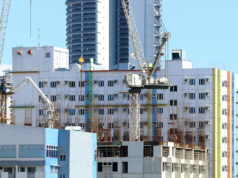WB cites PHL growth promise, risks
By Elijah Joseph C. Tubayan
Reporter
THE WORLD BANK sees the Philippines sustaining relatively robust growth in the medium term — though short of government target — but flagged capacity constraints and price pressures that may weigh on prospects.
According to the multilateral lender’s June 2018 Global Economic Prospects report released on Wednesday, Philippine gross domestic product (GDP) can be expected to grow by 6.7% in 2018 and 2019, unchanged from projections in the previous report in January, and 6.6% in 2020 — revised upward from 6.5% previously.
Those forecasts compare to the government’s 7-8% annual target until 2022, when President Rodrigo R. Duterte ends his six-year term.
Philippine GDP clocked 6.7% in 2017 against an official 6.5-7.5% target for that year.
Philippine growth projections are higher than East Asia and the Pacific’s 6.3%, 6.1% and 6.0% as well as the world’s 3.1%, 3.0% and 2.9% for 2018, 2019 and 2020, respectively, in the World Bank’s latest outlook.
The World Bank’s forecasts for the Philippines are slightly lower than the 6.8% and 6.9% estimates of the Asian Development Bank and the United Nations Economic and Social Commission for Asia and the Pacific for this year and next year, respectively, and compares with the International Monetary Fund’s 6.7% in 2018 and 6.8% in 2019.
The Philippines will be the fastest growing among most of the major East Asia and Pacific economies, including China, which itself is expected to grow 6.5%, 6.3% and 6.2% from 2018 to 2020.
Among the 14 East Asia and Pacific countries covered by the report, the Philippines will be outpaced by Cambodia (6.9%) and Vietnam (6.8%) this year, Laos and Myanmar (both at 6.9%) in 2019 and by Laos (6.9%) in 2019.
India in South Asia, another economy to which the Philippines is compared, is projected to grow by 7.3% this year and by 7.5% each for 2019 and 2020.
“Growth in the Philippines and Vietnam remains robust, but capacity constraints (e.g., high capacity utilization rates) limit further acceleration, especially in the Philippines,” read the report, which also cited “fast credit growth” as a source of vulnerability for the financial sector.
In its Philippine Economic Update report in April, the World Bank noted that the country was “at risk of overheating,” with manufacturing sector operating near full capacity amid growing consumer demand, which would drive up prices of widely used goods.
Moreover, the World Bank said in its latest outlook for East Asia and Pacific that China will weigh down regional growth due to its “gradual structural slowdown,” while activity for the rest of the region “is expected to peak in 2018 and remain steady around its potential rate in 2019 and 2020.”
“The outlook is predicated on broadly stable commodity prices in the next two years, solid but moderating global demand and a gradual tightening of global financing conditions,” the report read.
“For both commodity exporters and importers, capacity constraints and price pressures are expected to intensify over the forecast horizon, in part reflecting higher oil prices, leading to further tightening of monetary policy in the region.”
The World Bank cited increased protectionist tendencies, the imposition of trade restrictions by advanced economies and geopolitical tensions in the Korean peninsula as risks to the region’s growth prospects.
It also said that the economic impact of tariffs on imports by the US “would likely be manageable, provided they do not lead to escalation.”
“However, there is a risk that such measures may trigger retaliatory action and lead to broader trade restrictions,” the report clarified.
On the financial side, “a faster-than-expected tightening of global financing conditions and associated financing stress — triggered, for instance, by changes in market expectations of advanced-economy monetary policy — could reduce capital inflows, heighten financial market volatility, and place pressure on regional exchange rates and asset prices,” it added.
“Rising borrowing costs could substantially increase the burden of debt servicing, which was contained in recent years by low global interest rates and risk premiums. If a combination of downside risks were to materialize, it could trigger a sharper-than-expected slowdown in regional growth. Domestic vulnerabilities — elevated domestic debt and large external financing needs in some countries — would amplify the impact of external shocks, especially where policy buffers are limited, and dampen growth.”



